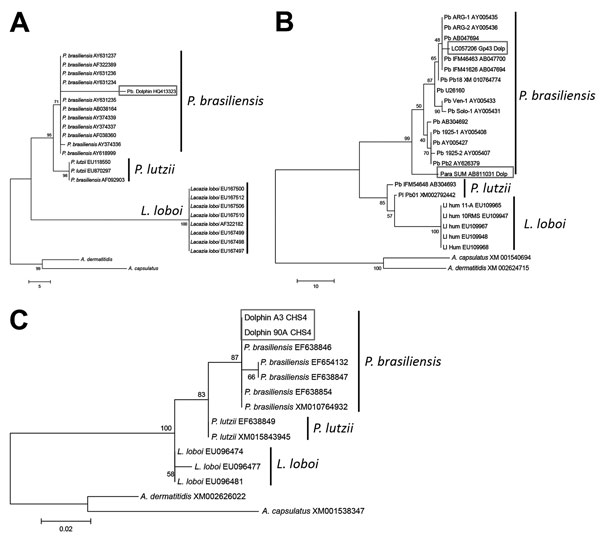Volume 22, Number 12—December 2016
Research
Cutaneous Granulomas in Dolphins Caused by Novel Uncultivated Paracoccidioides brasiliensis
Figure 4

Figure 4. Unrooted maximum-parsimony phylogenetic trees of A) partial internal transcribed spacer (ITS), B) 2 partial glycoprotein 43 (gp43) (12–14), and C) 2 partial chitin synthase 4 (CHS4) (A. Schaefer, P.J. McCarthy, unpub. data) gene sequences of Paracoccidioides brasiliensis. Sequences were obtained pathogen-infected bottlenose dolphins, Indian River Lagoon, Florida, USA, and compared with homologous sequences of cultivated Paracoccidioides brasiliensis (Pb), P. lutzii (Pi), and uncultivated Lacazia loboi (Ll) available in GenBank. Ajellomyeces capsulatus and A. dermatitidis CHS4, gp43, and ITS homologous sequences were used as outgroups. Strain names or accession numbers are shown. Numbers along branches are bootstrap values for 1,000 resamplings obtained by parsimony analysis, which support different clusters. P. brasiliensis ITS sequences from dolphins (14) grouped among cultivated P. brasiliensis ITS sequences. Distance between uncultivated P. brasiliensis from dolphins and cultivated P. brasiliensis from humans is unusually large (box in panel A). Placement of 2 gp43 P. brasiliensis sequences from dolphins (12,13) among cultivated P. brasiliensis strains (boxes in panel B). P. brasiliensis partial CHS4 gene sequences from 2 dolphins placed these sequences (GenBank accession no. KX267767 [A3] and KX267768 [90A]) within the P. brasiliensis cluster (box in panel C). Scale bars indicate nucleotide substitutions per site.
References
- Bossart GD. Suspected acquired immunodeficiency in an Atlantic bottlenosed dolphin with chronic-active hepatitis and lobomycosis. J Am Vet Med Assoc. 1984;185:1413–4.PubMedGoogle Scholar
- Bossart GD, Schaefer AM, McCulloch S, Goldstein J, Fair PA, Reif JS. Mucocutaneous lesions in free-ranging Atlantic bottlenose dolphins Tursiops truncatus from the southeastern USA. Dis Aquat Organ. 2015;115:175–84.DOIPubMedGoogle Scholar
- deVries GA, Laarman JJ. A case of Lobo’s disease in the dolphin Sotalia guianesis. Journal of Aquatic Mammals. 1973;1:26–33.
- da Lacaz S, Baruzzi RG, Rosa CB. Lobo’s disease [in Portuguese]. São Paulo: Editora da Universidad de IPSIS Gráfica e Editora; 1986.
- Migaki G, Valerio MG, Irvine B, Garner FM. Lobo’s disease in an atlantic bottle-nosed dolphin. J Am Vet Med Assoc. 1971;159:578–82.PubMedGoogle Scholar
- Woodard JC. Electron microscopic study of lobomycosis (Loboa loboi). Lab Invest. 1972;27:606–12.PubMedGoogle Scholar
- Schaefer AM, Reif JS, Guzmán EA, Bossart GD, Ottuso P, Snyder J, et al. Toward the identification, characterization and experimental culture of Lacazia loboi from Atlantic bottlenose dolphin (Tursiops truncatus). Med Mycol. 2016;54:659–65.DOIPubMedGoogle Scholar
- Silva ME, Kaplan W, Miranda JL. Antigenic relationships between Paracoccidioides loboi and other pathogenic fungi determined by immunofluorescence. Mycopathol Mycol Appl. 1968;36:97–106.DOIPubMedGoogle Scholar
- Taborda PR, Taborda VA, McGinnis MR. Lacazia loboi gen. nov., comb. nov., the etiologic agent of lobomycosis. J Clin Microbiol. 1999;37:2031–3.PubMedGoogle Scholar
- Herr RA, Tarcha EJ, Taborda PR, Taylor JW, Ajello L, Mendoza L. Phylogenetic analysis of Lacazia loboi places this previously uncharacterized pathogen within the dimorphic Onygenales. J Clin Microbiol. 2001;39:309–14.DOIPubMedGoogle Scholar
- Vilela R, Mendoza L, Rosa PS, Belone AF, Madeira S, Opromolla DV, et al. Molecular model for studying the uncultivated fungal pathogen Lacazia loboi. J Clin Microbiol. 2005;43:3657–61.DOIPubMedGoogle Scholar
- Vilela R, Rosa PS, Belone AFF, Taylor JW, Diório SM, Mendoza L. Molecular phylogeny of animal pathogen Lacazia loboi inferred from rDNA and DNA coding sequences. Mycol Res. 2009;113:851–7.DOIPubMedGoogle Scholar
- Rotstein DS, Burdett LG, McLellan W, Schwacke L, Rowles T, Terio KA, et al. Lobomycosis in offshore bottlenose dolphins (Tursiops truncatus), North Carolina. Emerg Infect Dis. 2009;15:588–90.DOIPubMedGoogle Scholar
- Minakawa T, Ueda K, Tanaka M, Tanaka N, Kuwamura M, Izawa T, et al. Detection of multiple budding yeast cells and a partial sequence of 43-kDa glycoprotein coding gene of Paracoccidioides brasiliensis from a case of lacaziosis in a female Pacific white-sided dolphin (Lagenorhynchus obliquidens). Mycopathologia. 2016;181:523–9.DOIPubMedGoogle Scholar
- Ueda K, Sano A, Yamate J, Nakagawa EI, Kuwamura M, Izawa T, et al. Two cases of lacaziosis in bottlenose dolphins (Tursiops truncates) in Japan. Case Reports in Veterinary Medicines. 2013;2013 [cited 2016 Sep 2]. https://www.hindawi.com/journals/crivem/2013/318548/
- Esperón F, García-Párraga D, Bellière EN, Sánchez-Vizcaíno JM. Molecular diagnosis of lobomycosis-like disease in a bottlenose dolphin in captivity. Med Mycol. 2012;50:106–9.DOIPubMedGoogle Scholar
- Thompson JD, Higgins DG, Gibson TJ. CLUSTAL W: improving the sensitivity of progressive multiple sequence alignment through sequence weighting, position-specific gap penalties and weight matrix choice. Nucleic Acids Res. 1994;22:4673–80.DOIPubMedGoogle Scholar
- Tamura K, Peterson D, Peterson N, Stecher G, Nei M, Kumar S. MEGA5: molecular evolutionary genetics analysis using maximum likelihood, evolutionary distance, and maximum parsimony methods. Mol Biol Evol. 2011;28:2731–9.DOIPubMedGoogle Scholar
- Reif JS, Mazzoil M, McCulloch SD, Varela RA, Goldstein JD, Fair PA, et al. Lobomycosis in Atlantic bottlenose dolphins (Tursiops truncatus) from the Indian River Lagoon, Florida. J Am Vet Med Assoc. 2006;228:104–8.DOIPubMedGoogle Scholar
- Haubold EM, Cooper CR Jr, Wen JW, McGinnis MR, Cowan DF. Comparative morphology of Lacazia loboi (syn. Loboa loboi) in dolphins and humans. Med Mycol. 2000;38:9–14.DOIPubMedGoogle Scholar
- Mendoza L, Belone AFF, Vilela R, Rehtanz M, Bossart GD, Reif JS, et al. Use of sera from humans and dolphins with lacaziosis and sera from experimentally infected mice for Western Blot analyses of Lacazia loboi antigens. Clin Vaccine Immunol. 2008;15:164–7.DOIPubMedGoogle Scholar
- Symmers WS. A possible case of Lôbo’s disease acquired in Europe from a bottle-nosed dolphin (Tursiops truncatus). Bull Soc Pathol Exot Filiales. 1983;76:777–84.PubMedGoogle Scholar
- Kiszka J, Van Bressem M-F, Pusineri C. Lobomycosis-like disease and other skin conditions in Indo-Pacific bottlenose dolphins Tursiops aduncus from the Indian Ocean. Dis Aquat Organ. 2009;84:151–7.DOIPubMedGoogle Scholar
- Paniz-Mondolfi A, Talhari C, Sander Hoffmann L, Connor DL, Talhari S, Bermudez-Villapol L, et al. Lobomycosis: an emerging disease in humans and delphinidae. Mycoses. 2012;55:298–309.DOIPubMedGoogle Scholar